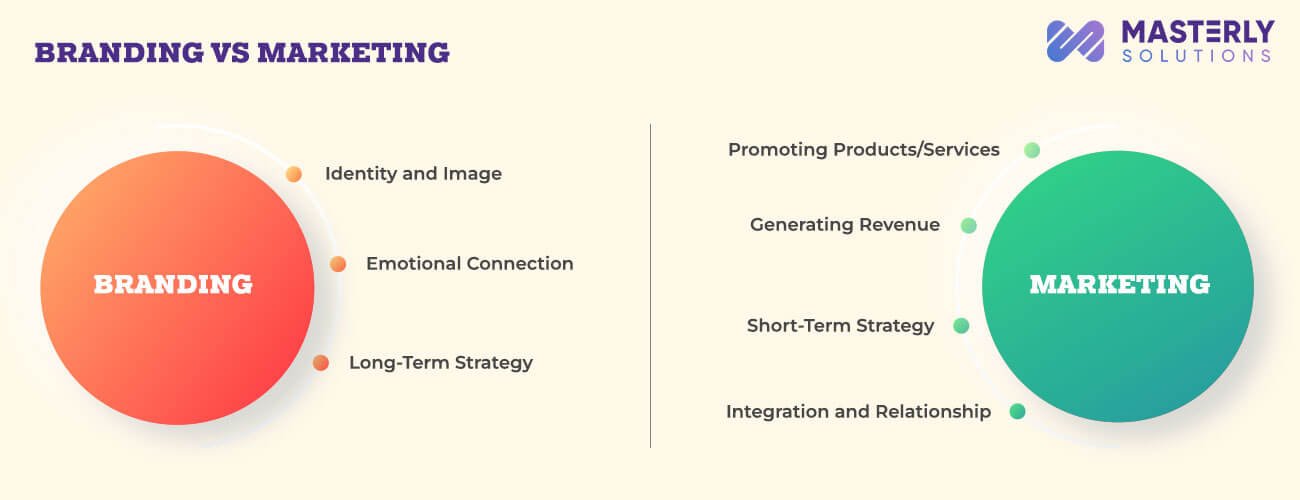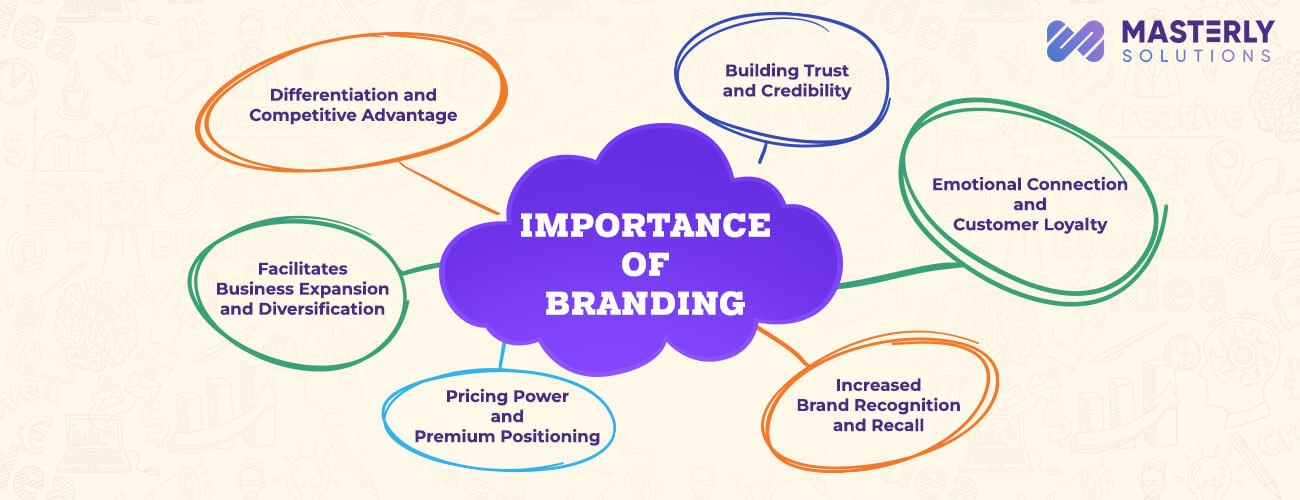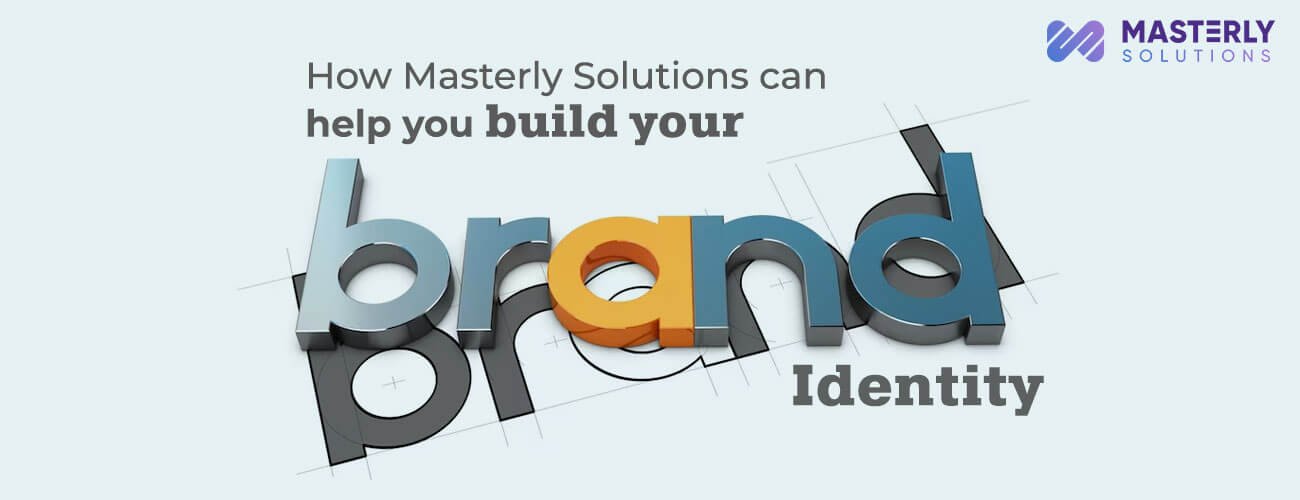Overview:

In today’s highly competitive marketplace, branding has become an essential aspect of any successful business. From small startups to multinational corporations, companies across various industries understand the power of a strong brand.
The role of branding in driving business growth cannot be underestimated. It encompasses the perception, emotions, and experiences associated with your business.
But what exactly is branding, and how does it impact business growth? In this article, we will delve into the significance of branding and tips about how to drive traffic to your website.
We will also give you guys important and actionable tips for effective brand strategies you can apply to your business.
What is branding?

Branding is a sort of process of creating a unique identity and image for your business, product, or service. It holds the values, personality, and overall experience that customers associate with your brand within.
Whether you want to create a software such as HRMS, hospitality management, IoT etc., or to develop a product, a strong brand conveys a sense of trust, credibility, and consistency to consumers. It involves the strategic development and management of various elements that shapes how the business is perceived by its target audience.
Branding involves carefully crafting and communicating a unique proposition that differentiates a business from its competitors. It encompasses the visual identity, including the logo, color scheme, typography, and design elements, as well as the messaging, tone of voice, and brand personality.
Branding extends to all touchpoints and interactions with customers, including marketing materials, website, packaging, customer services, and even the company culture and values.
The primary goal of branding is to create a positive and memorable impression in the minds of customers. It helps businesses connect with their target audiences on an emotional level, building relationships and fostering customer engagement.
An effective branding can drive customer preference, increase brand recognition, and ultimately contribute to the growth and success of a business.
Branding vs Marketing:

Branding and marketing are two distinct but interconnected aspects of a business’s overall strategy. While both play crucial roles in driving business growth, they serve different purposes and focus on different aspects of the customer journey.
Let’s explore the differences between branding and marketing:
Branding:
Branding is the strategic process of creating and managing a unique identity and perception for a business, product, or service. It is about establishing an emotional connection and shaping how customers perceive and experience a brand.
Here are some key points about branding:
Identity and Image:
Branding focuses on defining and creating a distinct identity for a business. It involves developing a brand name, logo, visual elements, messaging, and brand personality that differentiate the business from competitors.
Emotional Connection:
Branding aims to establish an emotional connection with customers by conveying the brand’s values, mission, and purpose. It shapes how customers feel and perceive a brand, influencing their decision-making process.
Long-Term Strategy:
Branding is a long-term endeavor that aims to build trust, credibility, and customer loyalty. It focuses on nurturing relationships and creating a positive brand reputation over time.
Marketing:
Marketing, on the other hand, is a tactical approach that focuses on promoting and selling products or services. It involves activities aimed at reaching, engaging, and influencing target customers to drive conversions and generate revenue.
Promoting Products/Services:
Marketing encompasses various strategies and tactics to promote and sell products or services. It includes advertising, public relations, sales promotions, content marketing, social media marketing, and more.
Generating Revenue:
The primary goal of marketing is to drive immediate sales and revenue by attracting customers, generating leads, and converting prospects into buyers.
Short-Term Strategy:
Marketing initiatives are typically shorter-term and campaign-focused. They are designed to achieve specific objectives, such as increasing sales, launching a new product, or driving website traffic.
Integration and Relationship:
Branding and marketing are interconnected and mutually reinforce each other. Effective marketing efforts are built on a strong brand foundation, and branding provides the framework for marketing activities. Branding shapes the messaging, tone, and visual identity used in marketing campaigns to ensure consistency and alignment with the brand’s identity.
On the other hand, marketing initiatives help amplify and communicate the brand’s value proposition to the target audience.
Importance of branding in business:

Branding is essential for the success and growth of an organization. It offers a multitude of benefits and advantages that contribute to building a strong and sustainable business.
Differentiation and Competitive Advantage:
In a jammed market, branding allows businesses to stand out from their competitors. It allows you to define and communicate what sets your business apart, whether it’s through unique product features, exceptional customer service, or a distinct brand personality.
A strong brand identity gives you a competitive edge and makes it easier for customers to choose your business over others.
Building Trust and Credibility:
A well-established brand creates trust and credibility among customers. When people have a positive perception of your brand and its offerings, they are more likely to trust your products or services. Trust leads to customer loyalty, repeat business, and positive word-of-mouth recommendations, which are invaluable for long-term growth.
Emotional Connection and Customer Loyalty:
Brands that successfully connect with customers on an emotional level can foster strong customer loyalty. When customers feel a sense of alignment with a brand’s values, mission, or purpose, they are more likely to become loyal advocates. Loyal customers not only continue to support your business but also become brand ambassadors, spreading positive word-of-mouth and attracting new customers.
Increased Brand Recognition and Recall:
A strong brand that is consistently represented across various touchpoints creates better brand recognition and recall. When people can easily identify and remember your brand, they are more likely to choose it when making purchasing decisions. Consistent branding across all marketing channels, such as your logo, tagline, and visual elements, helps reinforce brand visibility and recall.
Pricing Power and Premium Positioning:
A well-established brand with a positive reputation can command higher prices for its products or services. When customers perceive a brand as valuable, trustworthy, and of high quality, they are often willing to pay a premium. This pricing power can lead to increased profitability and higher profit margins.
Facilitates Business Expansion and Diversification:
A strong brand can serve as a solid foundation for business expansion and diversification. When customers have a positive association with your brand, they are more likely to try new products or services introduced under the same brand umbrella.
A well-established brand can provide a launching pad for entering new markets or introducing new offerings, reducing the barriers to entry and increasing the chances of success.
In a nutshell, Investing in branding efforts can yield significant returns by differentiating your business, building trust and loyalty, and ultimately driving long-term growth and success.
However, to ensure long-term success in business, it is essential to have a strong brand strategy that guides the path to achieving your goals.
Branding Strategy:

Brand strategy refers to the comprehensive plan and approach that guides the development, management, and positioning of a brand. It involves defining the brand’s identity, value proposition, target audience, messaging, and overall brand experience.
A well defined brand strategy provides a roadmap for creating a strong and consistent brand presence in the market. Here are key elements and considerations involved in developing an effective brand strategy:
Define Brand Identity:
Start by clearly defining your brand’s identity. Consider what sets your brand apart from competitors and how you want to be perceived by your target audience.
Identify Target Audience:
Identify your target audience and their requirements, preferences, and behaviors. This will help you tailor your branding efforts to effectively connect with and resonate with your target audience.
Craft Unique Value Proposition:
Define a unique value proposition that communicates the specific benefits and value your brand offers to customers. Identify what sets you apart from competitors and why customers should choose your brand. Your value proposition should be clear, compelling, and aligned with your target audience’s needs and desires.
Develop Brand Messaging:
Craft a consistent and compelling brand messaging framework that aligns with your brand’s identity and value proposition. This includes developing key messages, taglines, and a tone of voice that reflect your brand’s personality and resonates with your target audience.
Create Visual Brand Identity:
Design a visual brand identity that includes elements such as a logo, color palette, typography, and visual style. Ensure that these visual elements are aligned with your brand’s identity and consistently applied across all brand touchpoints.
Establish Brand Guidelines:
Develop brand guidelines that outline the proper usage of your brand elements and ensure consistency across all marketing and communication materials. These guidelines should include specifications for logo usage, color codes, typography, and brand tone of voice.
Align Brand Experience:
Ensure that the brand experience consistently delivers on the promises and expectations set by your brand strategy. This includes aligning all customer touchpoints, from product design and packaging to customer service and marketing communications, with your brand’s values and identity.
Monitor and Adapt:
Regularly monitor and evaluate the effectiveness of your brand strategy. Gather feedback from customers, track brand metrics, and stay informed about market trends and competitor activities. Use these insights to make necessary adjustments and adaptations to your brand strategy as needed.
By developing a well-defined brand strategy, businesses can establish a strong and consistent brand presence that resonates with their target audience.
But, while creating a strong brand strategy, it is very important to do strong research on the market so that you can come up with a unique strategy.
Market Research:

Market research plays a crucial role in informing and shaping your brand strategy. Here’s how market research can specifically contribute to your branding efforts:
Understanding Target Audience:
Market research helps you gain a deep understanding of your target audience’s preferences, needs, and behaviors. By conducting surveys, interviews, or focus groups, you can gather insights about their demographics, psychographics, and purchasing habits.
This information enables you to tailor your brand messaging, positioning, and visual identity to resonate with your target audience.
Assessing Brand Perception:
Through market research, you can measure and evaluate how your brand is currently perceived by your target audience. Surveys or brand perception studies can provide valuable insights into customers’ awareness, associations, and overall sentiment towards your brand.
This knowledge helps you identify gaps, strengths, and areas for improvement in your brand’s perception.
Competitor Analysis:
Market research allows you to conduct a comprehensive analysis of your competitors’ branding strategies. By studying their brand positioning, messaging, visual identity, and customer perception, you can identify opportunities to differentiate your brand and develop a unique value proposition.
Brand Positioning and Messaging:
Market research helps you determine the most effective brand positioning and messaging for your target audience. By testing different positioning statements or messaging concepts, you can gather feedback and insights to refine your brand’s communication strategy.
This ensures that your messaging resonates with your audience and effectively communicates your brand’s value.
Testing Brand Concepts and Visual Identity:
Market research can also be utilized to test and refine brand concepts, including logo designs, color schemes, taglines, and visual elements. By conducting surveys or focus groups, you can gather feedback on various design options and make data-driven decisions to create a compelling and visually appealing brand identity.
Tracking Brand Performance:
Market research enables you to track the performance and impact of your branding efforts over time. By conducting periodic brand health assessments or tracking brand metrics such as brand awareness, perception, and loyalty, you can gauge the effectiveness of your branding strategies and make adjustments as needed.
By conducting thorough market research specifically focused on branding, you can ensure that your brand strategy aligns with the needs and expectations of your target audience.
Define Your Personas:

Personas are essential for identifying your target audience and customizing your branding and marketing activities to fit their needs. They help you develop a deeper understanding of your audience’s characteristics, preferences, motivations, and behaviors.
Here’s how to define your personas:
Conduct Research:
Start by gathering data about your existing customers and target audience. Use surveys, interviews, analytics, and market research to collect information on demographics, psychographics, interests, challenges, and buying behaviors.
Identify Key Segments:
Analyze the data to identify common patterns and segments within your target audience. Look for similarities in age, gender, location, job titles, interests, or any other relevant factors that define your customer base.
Create Persona Profiles:
Based on the data and insights gathered, create individual persona profiles that represent specific segments of your audience. Each persona should have a name, demographic information, background details, goals, challenges, and preferred channels of communication.
Add Depth and Context:
Go beyond basic demographics and dig deeper into the motivations, aspirations, and pain points of each persona. Understand their preferred communication style, information sources, and purchase decision-making process. Add relevant personal details that make the persona more relatable and realistic.
Use Visuals:
Enhance your persona profiles by adding visual representations such as photos or illustrations. Visuals help bring the personas to life and make them more memorable for your team.
Continuously Update and Refine:
Regularly revisit and update your personas as your business evolves and new insights are gathered. Keep them aligned with the changing needs and preferences of your target audience.
By defining personas, you can better understand and empathize with your target audience.
Value of Consistent Branding:

A consistent brand holds immense value for businesses. It establishes trust and loyalty among customers, enhances brand recognition, and conveys professionalism and credibility.
Consistency in branding supports effective communication, reinforces brand differentiation, and facilitates brand expansion. It sets the foundation for long-term growth and success, creating a cohesive and memorable brand experience that resonates with customers.
By maintaining brand consistency across all touchpoints, businesses can create a strong and enduring brand presence that resonates with their target audience.
Overall, maintaining brand consistency is essential for building a strong and enduring brand presence in the market.
How Masterly Solutions Can Help You Build Your Brand Identity?

A successful business thrives on a strong brand identity. It distinguishes you from your competitors, communicates your values, and resonates with your target audience.
We understand the power of brand identity and offer a range of expert services to help you build a brand that captivates and inspires. Let’s explore how we can assist you in crafting your brand identity.
Developing a comprehensive brand strategy:
Building a brand starts with a well-defined strategy. Our strategists will work closely with you to understand your business goals, target audience, and market dynamics.
Through in-depth market research and competitor analysis, we identify your unique selling points and create a strategic roadmap to position your brand effectively.
Creating memorable visual identity:
A visually appealing and memorable logo is the cornerstone of brand identity. Our designers will collaborate with you to create a logo that reflects your brand’s personality, values, and aspirations.
Additionally, we will develop a strong visual identity system, including color schemes, typography, and imagery guidelines, ensuring consistency across all brand states.
Designing user-friendly websites and digital assets:
Your website frequently serves as the initial source of interaction for potential customers in the modern digital era. Our skilled web designers and developers will create a visually stunning website that reflects your brand identity.
We will ensure seamless integration of your visual elements, compelling content, and intuitive navigation to provide a memorable user experience.
Establishing consistent brand presence:
When it comes to brand identification, consistency is everything. We will assist you in implementing your brand identity across various touchpoints, including social media profiles, marketing collateral, packaging, and more.
We will develop brand guidelines that outline the correct usage of visual elements, tone of voice, and messaging to maintain a cohesive and recognizable brand presence.
Building strong brand recognition requires careful strategy, thoughtful design, and consistent marketing. By investing in a robust brand strategy and consistently delivering on brand promises, businesses can navigate the challenges of the modern marketplace and create a foundation for long-term success.
We offer thorough branding audit services to evaluate and analyze your brand strengths, weaknesses, opportunities, and threats.
Our in-depth research and analysis provide you with valuable insights and recommendations for enhancing your brand’s positioning and impact.
What’s Unique About our Branding Services?

Logo Design:
There is no doubt that the logo design is the visual foundation of any brand. We create a logo that captures the essence of your business and resonates with your target audience. We believe in the power of a well-crafted logo to convey your brand’s values and make a memorable impact.
Brand Style Guide:
Brand style is one of the most vital aspects of branding, and we offer strong and effective brand style services such as logo usage, color palette, typography, images, and visual elements to ensure that your brand identity remains consistent.
We believe that a well-defined brand style guide serves as a roadmap for maintaining brand integrity and enhancing brand recognition.
Content Creation:
Compelling and engaging content is vital for capturing the attention of your audience. Our content creators specialize in crafting captivating narratives that tell your brand story and connect with your customers.
From website copy and blog posts to social media captions and email marketing, we ensure that your brand’s voice is consistently compelling and persuasive.
Social Media Branding:
In today’s digital landscape, social media plays a crucial role in brand visibility and engagement. Our social media branding services help you stand out in the crowded social sphere.
We create eye-catching visuals, develop effective content strategies and implement targeted campaigns to increase your brand’s reach and foster meaningful connections with your audience.
Presentation design:
Our team of experts design aesthetically attractive and powerful proposals that effectively express your message and make a lasting impression. We ensure that your brand shines through every slide.
Brochure and stationery design:
When it comes to branding beautifully designed brochures and stationery is very important to elevate your band’s presence. We meticulously craft visually appealing and informative materials that reflect your brand’s personality and values.
From brochures to business cards to letterheads, we design great content that leaves a lasting impression.
Packaging and product design:
In a competitive market, packaging design plays a crucial role in attracting customers and conveying your brand’s value. We combine aesthetics, functionality and brand messaging to ensure your products make a significant impact.
Website design and development:
Your website tends to be your audience’s first point of contact. Our website design and development services focus on creating user-friendly, visually attractive websites that reflect your brand’s pinpoint.
We leverage the latest technologies and design trends to build smooth online experiences that convert visitors into loyal customers.
Based on the brand audit strategies, and services we provide actionable strategies and creative solutions to enhance your brand’s positioning and overall impact.
Branding Tips for Businesses:

- Be true to your brand’s identity and values. Authenticity builds trust and connection with customers.
- Go beyond traditional marketing tactics and create immersive brand experiences.
- Consider hosting events, workshops, or pop-up experiences that allow customers to engage with your brand on a deeper level.
- Encourage the public to write and share content that promotes your business. User-generated content, such as customer testimonials, reviews, and social media posts, adds authenticity and builds a sense of community around your brand.
- Identify influencers or thought leaders in your industry who align with your brand values and have a relevant audience.
- Use storytelling techniques to communicate your brand’s values, mission, and impact. Emotionally compelling stories have a higher chance of creating a lasting impression.
- Tailor your brand experiences to individual customers whenever possible.
- Demonstrate your brand’s commitment to social or environmental causes that align with your values.
- Collaborate with complementary brands to create unique co-branded products, services, or campaigns. This can help you tap into new customer segments, leverage shared brand equity, and create a buzz around your brand.
- Find opportunities to surprise and delight your customers. This could be through unexpected gifts, personalized notes, or exclusive experiences.
Remember, while implementing these unique branding tips, it’s essential to align them with your brand’s identity, values, and target audience.
By incorporating these strategies, businesses can differentiate themselves from competitors, create meaningful connections with customers, and build a strong and memorable brand presence.
Closure:
Branding plays a crucial role in the growth and success of a business and it is an ongoing process. It requires consistent effort, creativity, and adaptability. By investing in branding and implementing effective strategies, you can create a powerful brand that drives business growth, fosters customer loyalty, and sets your business up for long-term success.
Contact us to discuss your branding needs and let our experts do the rest.
